Harmony of the Gospels
A harmony of the gospels provides an important means for studying the four gospels at one time.
1. THE TEXT OF THE GOSPELS The text of one, two, three, or four gospels, depending on how many describe each episode, is found on each page of the "Harmony. "The gospel text is arranged in columns, and material in each column is placed so as to be adjacent to similar material in other columns. The width of the columns varies in accordance with how many gospels record the events of each section. The order of the gospels, from left to right, is the same as that in the modern editions of the New Testament.
2. SECTION NUMBERS The text of the gospels has been divided into sections and arranged in a probable chronological sequence. Each section has been assigned a number that appears in Arabic numerals at the beginning of each section heading. The numbering system is based on A. T. Robertson's" Harmony, "the 1922 revision of earlier John A. Broadus editions of the" Harmony. "In every case this new edition follows the sequence preferred by A. T. Robertson and assigns the same Arabic numerals to the sections. In some cases, however, Robertson's sections are too long and unwieldy. The editors have subdivided these sections, retained Robertson's section numbers, and added suffix letters to the numbers to indicate the subdivisions. Thus where Robertson simply had a Section 8, this edition has Section 8a, Section 8b, and Section 8c. As a result this edition can be used with other works based on the Robertson numbering system, but the student can deal with smaller units of text, units that more accurately reflect the natural divisions within the texts of the gospels.
3. SECTION TITLES Each section has been assigned a title. The titles areintended to be analytical and descriptive. The editors have not felt bound to use the wording of Robertson's section headings, just as Robertson himself was not bound by the headings in the earlier Broadus editions of the "Harmony."
4. SECTION CROSS-REFERENCES WITH POINTS OF SIMILARITY Just after some section titles are parenthetical notations begun by the abbreviation" cf. "and followed by other section numbers and a brief description of the point of similarity. These are sections that contain features in some way similar to the section where the cross-reference is in dicated. The "Table of Section Cross-References" on pp. 329-32 summarizes the points of similarity between all sections.
5. GEOGRAPHICAL NOTATIONS Below most section titles is a word or phrase set off by dashes, indicating the place where the events of that section took place.
6. SCRIPTURE REFERENCES Just above each column in the" Harmony "are the book name, chapters, and verses. These tell which biblical passage is found in that column.
7. OLD TESTAMENT QUOTATIONS The sources of quotations from the Old Testament are shown in brackets immediately after each quotation. The brackets indicate that these Old Testament references are not part of the NIV text itself, but are inserted into the text by the editors of the "Harmony "and express their own judgment. The perceptive reader will notice that frequently these same Old Testament references are also found in the NIV textual notes collected at the end of each section. The committee that controls the text of the NIV requires that in a work such as this" Harmony, "the textual notes be printed in their entirety, regardless of possible redundancy.
8. NIV TEXT NOTES ANDFORMAT FEATURES Superscript italic letters within the text (which follow the words with which they belong) refer to notes from the NIV translators dealing with such matters as alternate translations and uncertainty regarding the original text. Some sources of quotations from the Old Testament are also given in these notes. The NIV text notes are collected at the end of each" Harmony "section. These are related to the NIV text in the section above by book-chapter-verse notations, or by verse only whenever book and chapter are not needed for easy location.
To achieve clarity of style, the NIV translators sometimes supplied words not in the original texts but made necessary by the context. When there is uncertainty about such material, it is enclosed in brackets.
In the NIV prose is printed in paragraph form (rather than in verse divisions), and poetical passages are printed as poetry (that is, with indentations of lines and with separate stanzas). The "Harmony "preserves this format so far as possible, but the required rearrangements of material in a harmony sometimes make it impossible for paragraphs to be preserved as united wholes in one location.
9. EXPLANATORY FOOTNOTES Superscript boldface letters within the text or a heading (which precede the words with which they belong) refer to notes at the foot of the page. The explanatory notes, written by the revising editors, contain information especially helpful in harmonistic and comparative study of the gospels and the life and ministry of Jesus Christ. On occasion the revising editors also use them to explain how and why they disagree with A. T. Robertson's judgments on parallel passages and chronological sequence. Because thisedition is a revision of Robertson's Harmony published in 1922, it seemed best to retain Robertson's original arrangement and sequence of gospel materials and to place the revising editors' disagreements in the footnotes.
10. ALTERNATE CHRONOLOGICAL SEQUENCE When the revising editors differ with Robertson regarding chronological sequence, the alternate placement of a passage is indicated in the body of the Harmony by the section title and Scripture references enclosed in brackets. The text itself is not reprinted in such instances.



